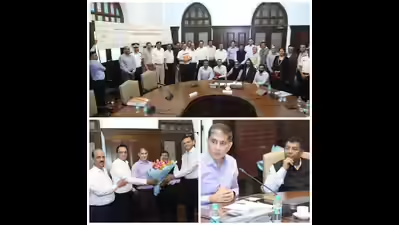Mumbai’s top real estate bodies — CREDAI-MCHI, NAREDCO, BDA, and PEATA — came together on October 24 for a crucial meeting with BMC Commissioner Bhushan Gagrani, discussing pressing challenges in the sector and proposing a more balanced 10:10:80 premium payment model.
Also read:-MCGM Property Tax: Download | Payment Online | Tax Bill
What’s the 10:10:80 Proposal All About?
Under the new proposed plan, developers suggest paying 10% of the premium at the time of project approval, another 10% during the Commencement Certificate (CC) stage, and the remaining 80% at the Occupation Certificate (OC) stage.
At present, developers are obligated to pay a variety of premiums upfront — including fungible FSI, open space deficiency, fire service charges, scrutiny fees, and development cess — or opt for deferment schemes that carry a steep 12% interest rate. These payments come at the initial stages of development, long before revenue starts coming in, making it financially straining for developers.
The 10:10:80 structure, if approved, could ease cash flow pressures and allow developers to link payments with actual project progress. Importantly, the proposal maintains that it would not impact civic revenues, but would instead make the payment process more practical and sustainable.
Also read:-Differences between Occupancy Certificate vs Completion Certificate
Understanding “Premium” in Real Estate
In Mumbai’s real estate ecosystem, premium refers to a range of charges that developers pay to civic authorities for project approvals and additional construction rights — such as extra built-up area or fungible FSI. There are more than 20 types of premiums levied on projects, contributing to nearly 20–30% of the overall project cost.
These costs are among the highest in the country, and developers have long argued for a more rationalized approach to ease financial stress, especially given the city’s complex approval framework.
Also read:-Municipal Tax on Commercial Property: Pay Online | Rules
Steering Committee to Strengthen Dialogue
Following the meeting, BMC Commissioner Bhushan Gagrani announced the formation of a dedicated steering committee that would bring together representatives from CREDAI-MCHI, NAREDCO, PEATA, and BDA, alongside officials from various MCGM departments — including the fire office.
The committee will meet fortnightly to address policy issues, streamline decision-making, and explore opportunities to strengthen Mumbai’s real estate growth. The meetings will be chaired by Deputy Chief Engineer Chandrashekhar Undge, with the BMC Commissioner himself joining monthly reviews to ensure accountability and steady progress.
Also read:-What Are The Government Taxes on Property Purchase in Mumbai
Industry Voices: A Step Toward Practical Reform
Sukhraj Nahar, President of CREDAI-MCHI, expressed optimism about the outcome of the discussions.
“It’s encouraging to see all real estate associations speak with one unified voice. The 10:10:80 payment model is a fair and pragmatic proposal that aligns payment timelines with project cash inflows while remaining revenue neutral for the administration,” he said.
Echoing the sentiment, Rushi Mehta, Secretary of CREDAI-MCHI, emphasized the importance of continued collaboration.
“The real estate industry is one of Mumbai’s key growth drivers. Regular engagement with civic authorities is essential to unlock its full potential. We hope this initiative leads to tangible reforms that benefit both the industry and the city.”
Also read:-How to Apply for a Property Mutation Certificate in Maharashtra in 2025?
A Step Toward Smoother Urban Development
The proposed payment model reflects a growing consensus that for Mumbai’s real estate to thrive, policy frameworks must evolve in tandem with the city’s changing economic and infrastructural needs. A transparent, balanced system could ensure steady development while supporting both the public and private stakeholders in the process.
Mumbai’s top real estate bodies — CREDAI-MCHI, NAREDCO, BDA, and PEATA — came together on October 24 for a crucial meeting with BMC Commissioner Bhushan Gagrani, discussing pressing challenges in the sector and proposing a more balanced 10:10:80 premium payment model.
Also read:-MCGM Property Tax: Download | Payment Online | Tax Bill
What’s the 10:10:80 Proposal All About?
Under the new proposed plan, developers suggest paying 10% of the premium at the time of project approval, another 10% during the Commencement Certificate (CC) stage, and the remaining 80% at the Occupation Certificate (OC) stage.
At present, developers are obligated to pay a variety of premiums upfront — including fungible FSI, open space deficiency, fire service charges, scrutiny fees, and development cess — or opt for deferment schemes that carry a steep 12% interest rate. These payments come at the initial stages of development, long before revenue starts coming in, making it financially straining for developers.
The 10:10:80 structure, if approved, could ease cash flow pressures and allow developers to link payments with actual project progress. Importantly, the proposal maintains that it would not impact civic revenues, but would instead make the payment process more practical and sustainable.
Also read:-Differences between Occupancy Certificate vs Completion Certificate
Understanding “Premium” in Real Estate
In Mumbai’s real estate ecosystem, premium refers to a range of charges that developers pay to civic authorities for project approvals and additional construction rights — such as extra built-up area or fungible FSI. There are more than 20 types of premiums levied on projects, contributing to nearly 20–30% of the overall project cost.
These costs are among the highest in the country, and developers have long argued for a more rationalized approach to ease financial stress, especially given the city’s complex approval framework.
Also read:-Municipal Tax on Commercial Property: Pay Online | Rules
Steering Committee to Strengthen Dialogue
Following the meeting, BMC Commissioner Bhushan Gagrani announced the formation of a dedicated steering committee that would bring together representatives from CREDAI-MCHI, NAREDCO, PEATA, and BDA, alongside officials from various MCGM departments — including the fire office.
The committee will meet fortnightly to address policy issues, streamline decision-making, and explore opportunities to strengthen Mumbai’s real estate growth. The meetings will be chaired by Deputy Chief Engineer Chandrashekhar Undge, with the BMC Commissioner himself joining monthly reviews to ensure accountability and steady progress.
Also read:-What Are The Government Taxes on Property Purchase in Mumbai
Industry Voices: A Step Toward Practical Reform
Sukhraj Nahar, President of CREDAI-MCHI, expressed optimism about the outcome of the discussions.
“It’s encouraging to see all real estate associations speak with one unified voice. The 10:10:80 payment model is a fair and pragmatic proposal that aligns payment timelines with project cash inflows while remaining revenue neutral for the administration,” he said.
Echoing the sentiment, Rushi Mehta, Secretary of CREDAI-MCHI, emphasized the importance of continued collaboration.
“The real estate industry is one of Mumbai’s key growth drivers. Regular engagement with civic authorities is essential to unlock its full potential. We hope this initiative leads to tangible reforms that benefit both the industry and the city.”
Also read:-How to Apply for a Property Mutation Certificate in Maharashtra in 2025?
A Step Toward Smoother Urban Development
The proposed payment model reflects a growing consensus that for Mumbai’s real estate to thrive, policy frameworks must evolve in tandem with the city’s changing economic and infrastructural needs. A transparent, balanced system could ensure steady development while supporting both the public and private stakeholders in the process.







